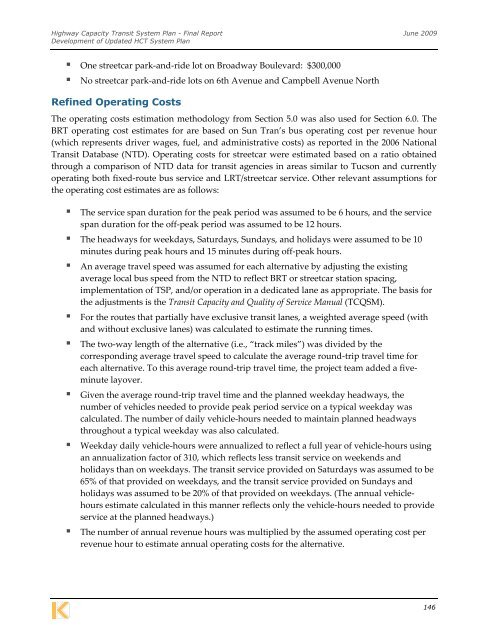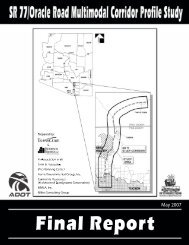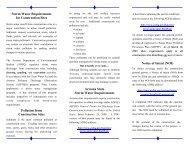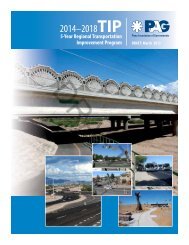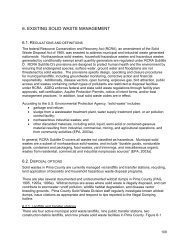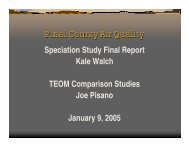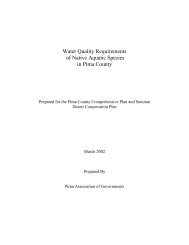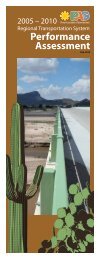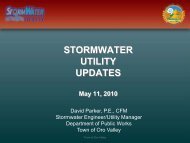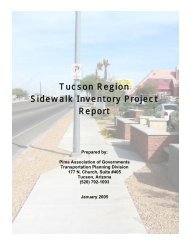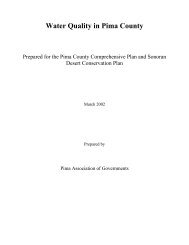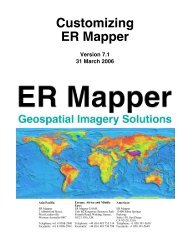Final Report - Pima Association of Governments
Final Report - Pima Association of Governments
Final Report - Pima Association of Governments
You also want an ePaper? Increase the reach of your titles
YUMPU automatically turns print PDFs into web optimized ePapers that Google loves.
Highway Capacity Transit System Plan - <strong>Final</strong> <strong>Report</strong> June 2009<br />
Development <strong>of</strong> Updated HCT System Plan<br />
• One streetcar park‐and‐ride lot on Broadway Boulevard: $300,000<br />
• No streetcar park‐and‐ride lots on 6th Avenue and Campbell Avenue North<br />
Refined Operating Costs<br />
The operating costs estimation methodology from Section 5.0 was also used for Section 6.0. The<br />
BRT operating cost estimates for are based on Sun Tran’s bus operating cost per revenue hour<br />
(which represents driver wages, fuel, and administrative costs) as reported in the 2006 National<br />
Transit Database (NTD). Operating costs for streetcar were estimated based on a ratio obtained<br />
through a comparison <strong>of</strong> NTD data for transit agencies in areas similar to Tucson and currently<br />
operating both fixed‐route bus service and LRT/streetcar service. Other relevant assumptions for<br />
the operating cost estimates are as follows:<br />
• The service span duration for the peak period was assumed to be 6 hours, and the service<br />
span duration for the <strong>of</strong>f‐peak period was assumed to be 12 hours.<br />
• The headways for weekdays, Saturdays, Sundays, and holidays were assumed to be 10<br />
minutes during peak hours and 15 minutes during <strong>of</strong>f‐peak hours.<br />
• An average travel speed was assumed for each alternative by adjusting the existing<br />
average local bus speed from the NTD to reflect BRT or streetcar station spacing,<br />
implementation <strong>of</strong> TSP, and/or operation in a dedicated lane as appropriate. The basis for<br />
the adjustments is the Transit Capacity and Quality <strong>of</strong> Service Manual (TCQSM).<br />
• For the routes that partially have exclusive transit lanes, a weighted average speed (with<br />
and without exclusive lanes) was calculated to estimate the running times.<br />
• The two‐way length <strong>of</strong> the alternative (i.e., “track miles”) was divided by the<br />
corresponding average travel speed to calculate the average round‐trip travel time for<br />
each alternative. To this average round‐trip travel time, the project team added a fiveminute<br />
layover.<br />
• Given the average round‐trip travel time and the planned weekday headways, the<br />
number <strong>of</strong> vehicles needed to provide peak period service on a typical weekday was<br />
calculated. The number <strong>of</strong> daily vehicle‐hours needed to maintain planned headways<br />
throughout a typical weekday was also calculated.<br />
• Weekday daily vehicle‐hours were annualized to reflect a full year <strong>of</strong> vehicle‐hours using<br />
an annualization factor <strong>of</strong> 310, which reflects less transit service on weekends and<br />
holidays than on weekdays. The transit service provided on Saturdays was assumed to be<br />
65% <strong>of</strong> that provided on weekdays, and the transit service provided on Sundays and<br />
holidays was assumed to be 20% <strong>of</strong> that provided on weekdays. (The annual vehiclehours<br />
estimate calculated in this manner reflects only the vehicle‐hours needed to provide<br />
service at the planned headways.)<br />
• The number <strong>of</strong> annual revenue hours was multiplied by the assumed operating cost per<br />
revenue hour to estimate annual operating costs for the alternative.<br />
146


